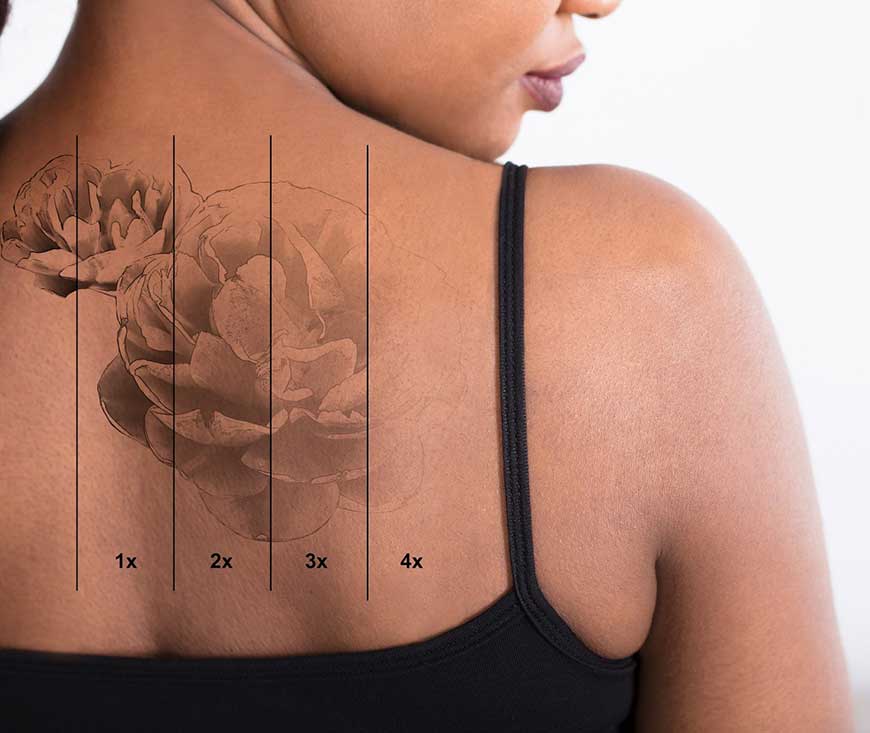Tattoo removal methods have been available for as long as tattoos have existed. Tattoos are either professionally done, done by amateurs or in our culture within tribal and scarification marks.
What are the methods of tattoo removal available?
Various methods of removal are available. The methods we have available at SKIN101 include:
Dermabrasion is a way of tattoo removal with the help of diamond polishing technology. This procedure takes a longer time and demands a number of clinic visits. Its point is cutting off the skin layers one by one until the tattoo finally disappears. The main disadvantage is the danger of leaving scars on the skin, which can be very difficult to get rid of.

Laser tattoo removal is the most effective but also the most expensive method. Modern lasers can remove a tattoo with very few visits by influencing different skin layers. This method rarely leaves any scars and its only drawback is the price. We have a powerful Sandstone Ultralight Q, a Q-switched ND:YAG laser with wavelengths 1064nm and 532nm that can remove dark colored inks like black, blue and red. This laser is well suited to be used on dark African skin. Our laser does not remove greens and yellows.
How long does a session of laser tattoo removal take and how many sessions do I need?
We apply a numbing cream 45minutes to 1 hour before the procedure to make the procedure as comfortable for the patient as possible. Most patients compare the feeling during the tattoo removal process as a rubber-band-snapping-against-the skin feeling. The laser treatment itself takes 10 to 30 minutes depending on the size of the tattoo.
Most patients require 3 to 8 sessions to remove the ink considerably. The number of sessions needed will depend on many factors. If done by a professional tattoo artist, the ink will be deeper and more intense than if done by an amateur requiring more sessions. If the tattoo is old, it will require less sessions as it would have less ink already.
In the case of tribal and scarification marks, there are 2 components to take care of. The ink, which can be removed by the laser and the indented or raised scar that will then be treated by other methods.
Note that we carry out a patch test weeks before treatment commences to see how individual skins will respond to the laser.
How does laser tattoo removal work?
Lasers remove tattoos by breaking up the pigment colors of the tattoo with a high-intensity light beam.The broken-down ink is then absorbed by the body and excreted, mimicking the natural fading that time or sun exposure would create.
Black tattoo pigment absorbs all laser wavelengths, making it the easiest to treat. Other colors can only be treated by selected lasers based upon the pigment color. Yellows, greens and fluorescent colors are the most challenging to remove, mostly requiring a very expensive picosure laser
What are the side-effects of laser tattoo removal?
There are minimal side effects to laser tattoo removal. However, you should consider these factors in your decision:
- The tattoo removal site is at risk for infection. You may also risk lack of complete pigment removal, and there is a slight chance that the treatment can leave you with a permanent scar which may be raised (keloidal) or indented (atrophic).
- You may also risk hypopigmentation, where the treated skin is paler than surrounding skin, or hyperpigmentation, where the treated skin is darker than surrounding skin.
- Cosmetic tattoos like lip liner, eyeliner, and eyebrows may darken following treatment with tattoo removal lasers. Further treatment of the darkened tattoos usually results in fading.

